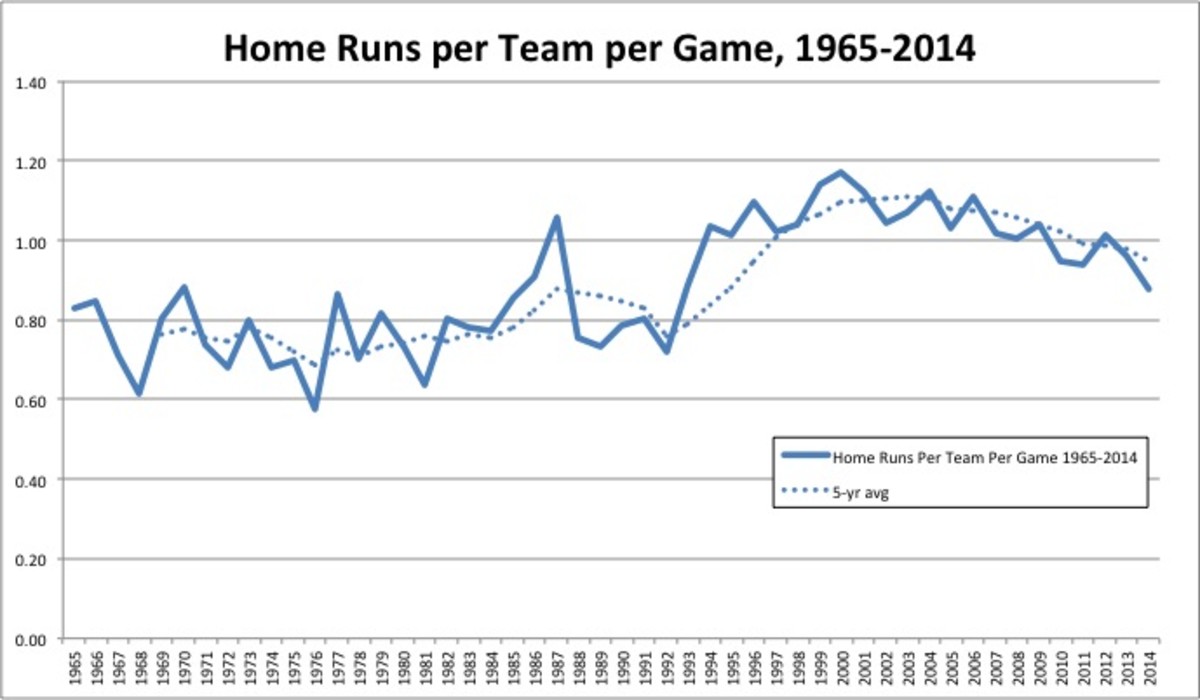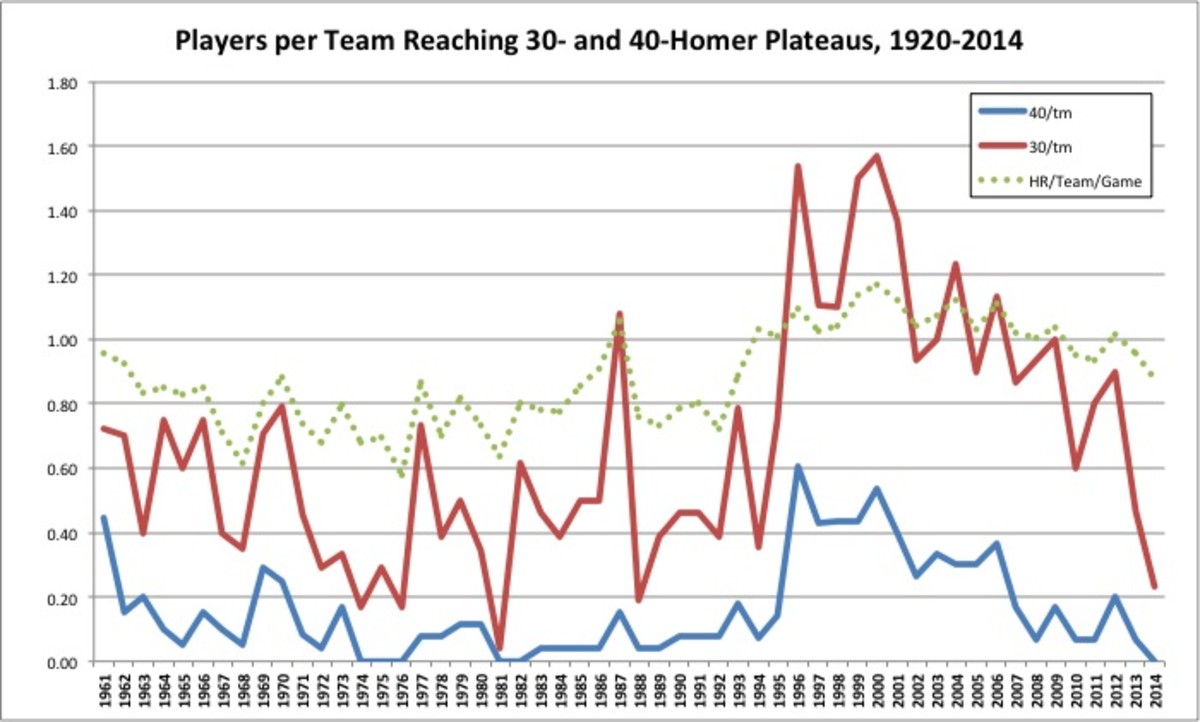The case of the disappearing slugger: Where did MLB's power go?

On Tuesday night, Giancarlo Stanton bashed his National League-leading 35th home run, and he did it with typical flair, connecting for a shot off the "Marlinator" home run sculpture, an estimated 414 feet away in centerfield, at the expense of the Mets' Jon Niese:
Stanton's homer was his second in as many days, and while he won't maintain that blistering pace, he still has his work cut out to reach 40 for the season, something he’s never done before; he bopped 37 in 2012 despite being limited to just 123 games due to injuries. Barring five homers from him or a monster 10-homer month from Anthony Rizzo, the only other Senior Circuit slugger with more than 26, the NL will be without a 40-homer hitter for the second straight season, something that hasn't happened since 1991 and '92.
Ranking the best and worst MLB free agent signings of 2014
Forty homers is no given in the AL, either. While Nelson Cruz leads the majors with 36 after going deep in back-to-back games on Aug. 31 and Sept. 1, 20 of them came in April and May; since then, he's hit just .218/.285/.407 with 16 homers, one for every 21.5 plate appearances. Given Baltimore's 25 remaining games and possibly 100 plate appearances for Cruz, it’s still likely that he reaches 40, but he'll need to avoid a long outage. If he can't, Jose Abreu and Chris Carter, both with 33, will have to mash with increased impunity to prevent this from being the first season since 1982 in which nobody gets to that plateau.
The odds are that at least one of those four sluggers will do it, but even so, it's worth considering the disappearance of the longball. This will be the second season in a row and fourth out of five in which teams have hit fewer than one per game. The current rate of 0.88 per team per game is down 8.6 percent from last year (0.96 per game) and down 13.7 percent from 2012 (1.04 per game); in fact, it's the lowest rate since 1992 (0.72 per game). If that pace is maintained, it will mean 403 fewer homers than last year, 675 fewer than in 2012 and 1,435 fewer than in 2000, the year home runs reached their absolute zenith (1.17 per game). For context, here's what the last half-century looks like:

As you can see, prior to the strike-shortened 1994 season, home runs had only once surpassed the level of 1.0 per game — in the strange, offense-happy 1987 season. A confluence of factors conspired to push the annual level past 1.0 over a range of nearly two decades. Smaller ballparks, the changing strike zone, a dilution of pitching talent due to expansion and the influx of performance-enhancing drugs were often credited (or blamed), sometimes erroneously, particularly with regards to parks with fewer seats but further fence distances. My studies for Will Carroll's book The Juice (2005) and Baseball Prospectus' Extra Innings (2012) showed that the move into high-altitude Denver, as well as a change in the composition of the baseball itself and extremely wide tolerances in the specifications of those balls — "So loose that the range of performance from the top end to the bottom end is so different," according to baseball physics expert Alan Nathan — also played significant roles.
CORCORAN: Eliminated Rangers couldn't cope with endless injuries
Likewise, the introduction of random PED testing with substantial suspensions is often credited for the decline of the homer, though it's hardly been a uniform one. The continued introduction of more pitcher-friendly parks such as Citi Field, Nationals Park, Target Field and the new Busch Stadium have played their part, as has the onslaught of high-velocity pitching, and given what's gone on in MLB historically as well as Japan more recently, one can't dismiss the possibility that the composition of the ball has been monkeyed with again.
News and notes: Pujols contemplates retirement, Oakland's August skid
With regard to the pitching, it's worth noting that even if one adjusts for the rising strikeout rates, home runs per batted ball — that's HR / (AB - SO + SF), often referred to as HR/Con, short for Contact — tells virtually the same story in terms of the above graph's peaks and valleys. The current rate of 3.28 percent is the lowest since 1993 (3.10 percent), down from 3.57 percent last year, 3.79 percent in 2012, and a high of 4.14 percent in 2000; prior to 1994, it had been above 3.20 percent only in 1987, when it was 3.71 percent.
Back to individual performances, here's a long-term look at the number of players reaching the 30- and 40-homer marks, adjusted for the number of major league teams. You can see that it goes hand-in-hand with the MLB-wide rate of homers per team per game — so well that the correlations are .88 and .72, respectively:

The relationship is a bit more random with regards to the 40-homer plateau due to the relatively minimal frequency. Follow the blue line above and you can see that prior to 1996, one had to go all the way back to the 1961 expansion for a season with 0.4 40-homer sluggers per team (one for every 2.5 teams) and to 1970 for 0.2 per team (one for every five teams), but from 1996-2001, the rate was at least 0.4 for every year. It remained above 0.2 through 2006, a level it's grazed only once since, in 2012. To put it another way, the majors had never seen double-digit totals of 40-homer sluggers until 1996, when 17 players reached that plateau; at least a dozen did so every year through 2001. Since then, we’ve seen double digits here and there — 10 in 2003, 11 in 2006 — but only twice in the 2008-13 span were there more than two.
Health of Cabrera, Hosmer is key to race between Tigers, Royals
More alarming is the increasing scarcity of the 30-homer hitter. In 1987, 28 players reached that milestone, the first time there had been an average of 1.0 per team. From 1996-2009, only four times did that rate fall below 1.0, and only once (2007) did it fall below 0.9; since then, it's been at 0.9 just once (2012), and last year it fell below 0.5 for the first non-strike season since 1992.
Falling home run rates have gone hand in hand with falling levels of overall scoring. This year's 4.10 runs per game is down 1.5 percent from last year's 4.17 per game, down 5.2 percent from 2012's 4.32 per game, and down 11.1 percent from 2009's 4.61 per game, the last time it was above 4.50. It's the lowest rate since the strike-shortened 1981 season (4.00), or since 1978 (4.10) if you prefer full 162-game slates. The combination of factors — increases in strikeout and groundball rates, pitcher velocities and the number of infield shifts — has been much discussed at this site and elsewhere, with some suggesting remedies whose consequences may be worse than the problem they purport to solve.
As somebody who believes that the game is constantly evolving, I'm less sure that action needs to be taken. Pitchers have enough working against them with regard to the physical stresses inherent to their craft that doing anything to make their jobs harder — lowering the mound, shrinking the strike zone, outlawing defensive shifts or shortening fence distances, say — seems like madness that will only increase the number of hurlers who wind up on operating tables.
CORCORAN: Gomez-less Brewers are in trouble in NL Central
I do think that over the next several years, we'll see an increased emphasis on contact hitting to counter the spate of strikeouts and on whole-field usage to counter the number of shifts, though such things will take time to bubble up through the amateur ranks and the minors. Likewise, the shockingly high number of Tommy John surgeries will hopefully lead to smarter management of pitchers beginning at the amateur level, with pitch counts, innings limits and mandatory rest more rigorously enforced. Ideally, pitchers will reach the professional ranks with less wear and tear than the current crop of already-damaged hurlers, enabling teams' varying strategies with regards to pitch counts, innings caps — and perhaps an encouragement to dial back the velocity a bit for the sake of protection — to bear fruit in terms of reducing injuries. Likely, teams will also find that not all defensive shifting is bearing fruit; some teams give up higher batting averages on balls in play with the shift on than without it, and I suspect an equilibrium will be reached as each organization finds its own comfort level.
There's no guarantee that any of those changes will take hold, however. Even if they do, they'll take time to work their way to the major league level, and even longer to form a discernible trend. But so long as the industry is financially sound — and the current national television contracts that run through 2021 go a long way toward ensuring that, to say nothing of strong regional ratings and the increased growth of MLB Advanced Media — the game has time to evolve without drastic intervention. Assuming that happens, we won’t have to bemoan the disappearance of the 30- and 40-homer sluggers to which we’ve become so accustomed, but in a worst case scenario, at least we’ll have the 24-year-old Stanton around for a good while longer.
